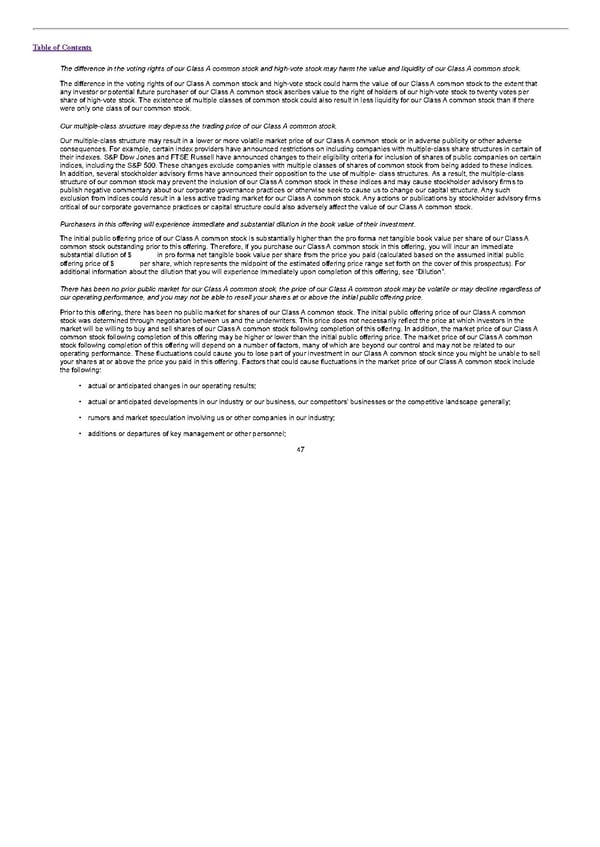Table of Contents The difference in the voting rights of our Class A common stock and high-vote stock may harm the value and liquidity of our Class A common stock. The difference in the voting rights of our Class A common stock and high-vote stock could harm the value of our Class A common stock to the extent that any investor or potential future purchaser of our Class A common stock ascribes value to the right of holders of our high-vote stock to twenty votes per share of high-vote stock. The existence of multiple classes of common stock could also result in less liquidity for our Class A common stock than if there were only one class of our common stock. Our multiple-class structure may depress the trading price of our Class A common stock. Our multiple-class structure may result in a lower or more volatile market price of our Class A common stock or in adverse publicity or other adverse consequences. For example, certain index providers have announced restrictions on including companies with multiple-class share structures in certain of their indexes. S&P Dow Jones and FTSE Russell have announced changes to their eligibility criteria for inclusion of shares of public companies on certain indices, including the S&P 500. These changes exclude companies with multiple classes of shares of common stock from being added to these indices. In addition, several stockholder advisory firms have announced their opposition to the use of multiple- class structures. As a result, the multiple-class structure of our common stock may prevent the inclusion of our Class A common stock in these indices and may cause stockholder advisory firms to publish negative commentary about our corporate governance practices or otherwise seek to cause us to change our capital structure. Any such exclusion from indices could result in a less active trading market for our Class A common stock. Any actions or publications by stockholder advisory firms critical of our corporate governance practices or capital structure could also adversely affect the value of our Class A common stock. Purchasers in this offering will experience immediate and substantial dilution in the book value of their investment. The initial public offering price of our Class A common stock is substantially higher than the pro forma net tangible book value per share of our Class A common stock outstanding prior to this offering. Therefore, if you purchase our Class A common stock in this offering, you will incur an immediate substantial dilution of $ in pro forma net tangible book value per share from the price you paid (calculated based on the assumed initial public offering price of $ per share, which represents the midpoint of the estimated offering price range set forth on the cover of this prospectus). For additional information about the dilution that you will experience immediately upon completion of this offering, see “Dilution”. There has been no prior public market for our Class A common stock, the price of our Class A common stock may be volatile or may decline regardless of our operating performance, and you may not be able to resell your shares at or above the initial public offering price. Prior to this offering, there has been no public market for shares of our Class A common stock. The initial public offering price of our Class A common stock was determined through negotiation between us and the underwriters. This price does not necessarily reflect the price at which investors in the market will be willing to buy and sell shares of our Class A common stock following completion of this offering. In addition, the market price of our Class A common stock following completion of this offering may be higher or lower than the initial public offering price. The market price of our Class A common stock following completion of this offering will depend on a number of factors, many of which are beyond our control and may not be related to our operating performance. These fluctuations could cause you to lose part of your investment in our Class A common stock since you might be unable to sell your shares at or above the price you paid in this offering. Factors that could cause fluctuations in the market price of our Class A common stock include the following: • actual or anticipated changes in our operating results; • actual or anticipated developments in our industry or our business, our competitors’ businesses or the competitive landscape generally; • rumors and market speculation involving us or other companies in our industry; • additions or departures of key management or other personnel; 47
 S1 - WeWork Prospectus Page 51 Page 53
S1 - WeWork Prospectus Page 51 Page 53